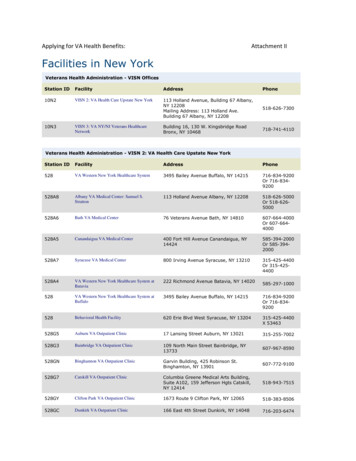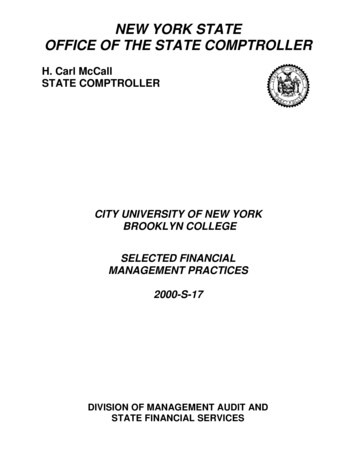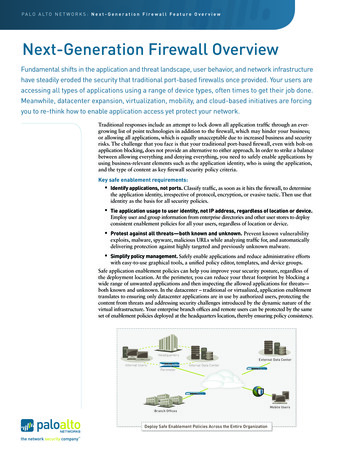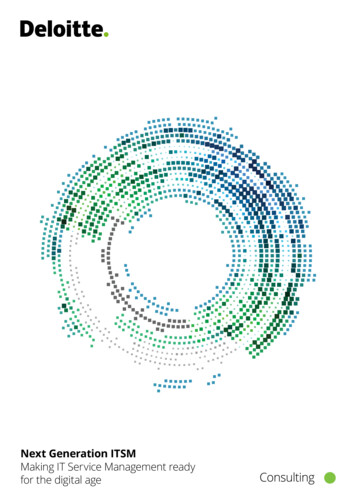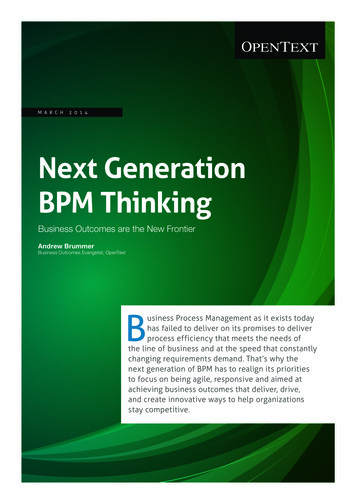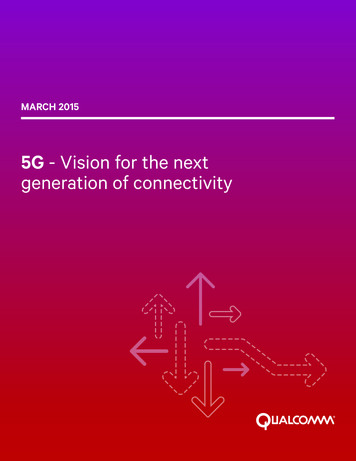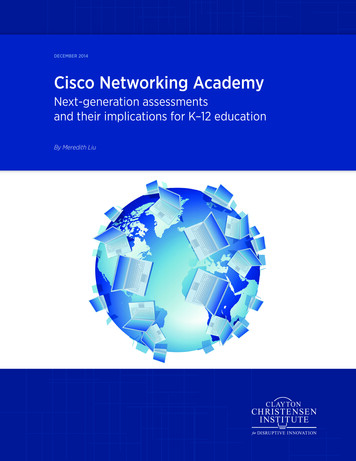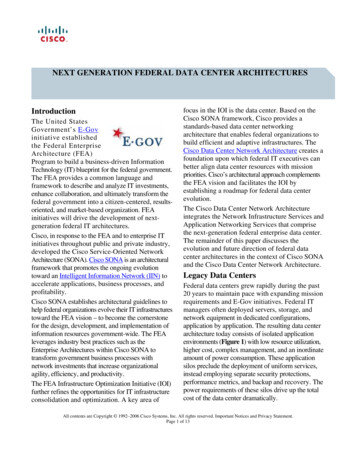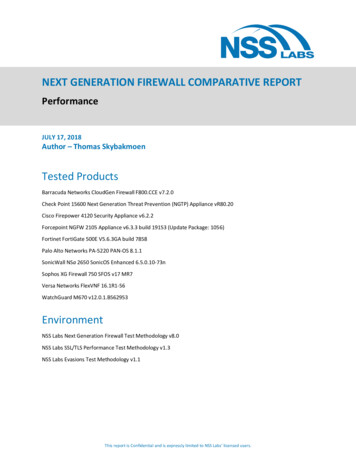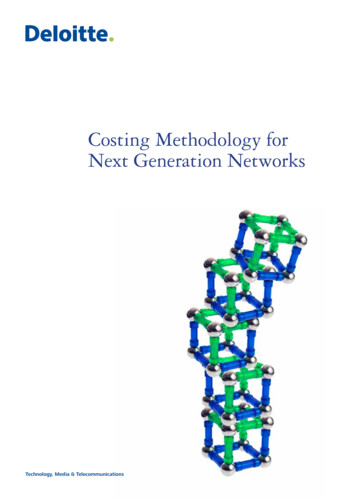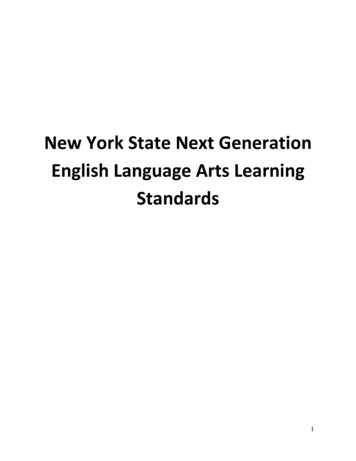
Transcription
New York State Next GenerationEnglish Language Arts LearningStandards1
Table of ContentsAnchor Standards .3Lifelong Practices of Readers and Writers.7Prekindergarten and Elementary Standards .8Middle Grades Standards 57High School Standards .79Appendix A (Language Standard 1 and 2) 94Appendix B: Glossary of Terms 992
English Language Arts Anchor StandardsAnchor standards represent broad statements about the expectations for students as they prepare for highschool graduation, positioning them for college and careers. The grade level ELA standards begin in thePrekindergarten and Elementary ELA Standards section. Please see the introduction for more about how theanchor standards and grade level standards connect.Reading Anchor StandardsPlease note: For the grade level and grade band standards, RI and RL are included to showhow the standard applies to either reading informational (RI) or literary texts (RL), or both(RI&RL).Key Ideas and DetailsStandard 1: Read closely to determine what the text says explicitly/implicitly and make logicalinferences from it; cite specific textual evidence when writing or speaking to supportconclusions drawn from the text.Standard 2: Determine central ideas or themes of a text and analyze their development;summarize the key supporting details and ideas.Standard 3: Analyze how and why individuals, events, and ideas develop and interact over thecourse of a text.Craft and StructureStandard 4: Interpret words and phrases as they are used in a text, including determiningtechnical, connotative, and figurative meanings, and analyze how specific word choices shapemeaning or tone.Standard 5: Analyze the structure of texts, including how specific sentences, paragraphs,and larger portions of the text (e.g., a section, chapter, scene, or stanza) relate to eachother and the whole.Standard 6: Assess how point of view or purpose shapes the content and style of a text, drawingon a wide range of global and diverse texts.Integration of Knowledge and Ideas3
Standard 7: Integrate and evaluate content presented in diverse media and formats.Standard 8: Delineate and evaluate the argument and specific claims in a text, including thevalidity of the reasoning as well as the relevance and sufficiency of the evidence.Standard 9: Analyze and evaluate texts using knowledge of literary forms, elements, anddevices through a variety of lenses and perspectives.Writing Anchor StandardsText Types and PurposesStandard 1: Write arguments to support claims in an analysis of substantive topics or texts,using valid reasoning and relevant and sufficient evidence.Standard 2: Write informative/explanatory texts to examine and convey complex ideas andinformation clearly and accurately through the effective selection, organization, and analysis ofcontent.Standard 3: Write narratives to develop real or imagined experiences or events using effectivetechniques, well-chosen details, and well-structured event sequences.Standard 4: Develop personal, cultural, textual, and thematic connections within and acrossgenres through written responses to texts and personal experiences.Standard 5: Draw evidence from literary or informational texts to support analysis, reflection,and research.Research to Build and Present KnowledgeStandard 6: Conduct research based on focused questions to demonstrate understanding ofthe subject under investigation.Standard 7: Gather relevant information from multiple sources, assess the credibility andaccuracy of each source, and integrate the information in writing while avoiding plagiarism.4
Speaking and ListeningComprehension and CollaborationStandard 1: Prepare for and participate effectively in a range of conversations andcollaborations with diverse partners; express ideas clearly and persuasively, and build onthose of others.Standard 2 Integrate and evaluate information presented in diverse media and formats(including visual, quantitative, and oral).Standard 3: Evaluate a speaker’s point of view, reasoning, and use of evidence and rhetoric.Presentation of Knowledge and IdeasStandard 4: Present information, findings, and supporting evidence so that listeners canfollow the line of reasoning. Ensure that the organization, development, and style areappropriate to task, purpose, and audience.Standard 5: Make strategic use of digital media and visual displays to express information andenhance understanding of presentations.Standard 6: Adapt speech to a variety of contexts and communicative tasks, demonstratingcommand of academic English when indicated or appropriate.Language StandardsConventions of Academic English/Language for LearningStandard 1: Demonstrate command of the conventions of academic English grammar and usagewhen writing or speaking.Standard 2: Demonstrate command of the conventions of academic English capitalization,punctuation, and spelling when writing.5
Knowledge of LanguageStandard 3: Apply knowledge of language to understand how language functions in differentcontexts, to make effective choices for meaning or style, and to comprehend more fullywhen reading or listening.Vocabulary Acquisition and UseStandard 4: Determine or clarify the meaning of unknown and multiple-meaning words andphrases by using context clues, analyzing meaningful word parts, and consulting general andspecialized reference materials, as appropriate.Standard 5: Demonstrate understanding of figurative language, word relationships and nuancesin word meanings.Standard 6: Acquire and accurately use general academic and content-specific words andphrases sufficient for reading, writing, speaking, and listening; demonstrate independence ingathering and applying vocabulary knowledge when considering a word or phrase importantto comprehension or expression.6
Lifelong Practices of Readers and WritersLifelong Practices of ReadersLifelong Practices of WritersReadersWriters think, write, speak, and listen tounderstand read often and widely from a range ofglobal and diverse texts read for multiple purposes, including forlearning and for pleasure self-select texts based on interest persevere through challenging, complextexts enrich personal language, backgroundknowledge, and vocabulary throughreading and communicating with others monitor comprehension and applyreading strategies flexibly make connections (to self, other texts,ideas, cultures, eras, etc.) think, read, speak, and listen to supportwriting write often and widely in a variety offormats, using print and digital resourcesand tools write for multiple purposes, including forlearning and for pleasure persevere through challenging writingtasks enrich personal language, backgroundknowledge, and vocabulary throughwriting and communicating with others experiment and play with language analyze mentor texts to enhance writing strengthen writing by planning, revising,editing, rewriting, or trying a newapproach7
Prekindergarten and Elementary EnglishLanguage Arts Learning Standards8
New York State Prekindergarten English Language ArtsLearning StandardsPlease note: These Standards are intended for four-year-old prekindergarten students.Prekindergarten IntroductionGuidance and SupportGuidance and support are an integral part of developmentally appropriate practice. As childrenare gaining mastery of the standards in prekindergarten, some students may require support todemonstrate skills.Range of Student Reading Experiences for PrekindergartenStudents in prekindergarten should experience a balance of literature and informational texts inthe context of instruction designed to create opportunities for children to engage with a varietyof topics, and texts, and have discussions about texts that support language development andknowledge building. Creating this learning environment for emergent readers can take a varietyof formats, including read-alouds, shared readings, pretend readings, learning activities andplay that incorporates literacy materials, talking, experimenting with written materials, andother literacy activities. We refer to these instructional events as ‘reading or literacyexperiences’ because the focus is on using texts, printed and visual, to develop emergentreaders’ concepts of how meaning is conveyed through reading and writing while building theirlanguage and knowledge.It is not enough to simply feature a variety of literary and informational text types inPrekindergarten environments and classroom instruction; these texts must be made accessibleand meaningful to young readers as a component of fostering engagement with literacy tobuild language and knowledge. For example, educators should provide and engage developingreaders with an assortment of fiction and non-fiction age-appropriate books in the library areathat are displayed attractively and used regularly, rotated often; connected to instructionalthemes and feature cultural diversity; incorporate text materials into many different aspects ofthe classroom curriculum, including authentic informational text materials for use in play and toguide learning centers; and select a variety of text types that engage children’s interests andsupport their learning about the themes under study.The following are examples of literary and informational text types to be used in classroominstruction and to create the literacy-rich learning environments. Texts are not limited to theseexamples.Literature: picture books, stories, drama, poetry, fiction, fairytales, nursery rhymes, folktales, tall tales, and other literary texts.9
Informational Text: picture books, nonfiction, biographies, autobiographies, books andarticles about science, art, history, social studies, and information displayed in charts,graphs, or maps, in both print and digital sources.Text Complexity Expectations for PrekindergartenStudents in Prekindergarten are at the early emergent reader level and haven’t developedthe foundational word reading skills necessary to read texts independently. However, it iscrucial that prekindergarten students actively engage in large and small group interactive readaloud discussions of texts that are content-rich and age-appropriate. These texts should bepart of the curricular materials as well as those best sellers from a variety of publishers found inlibraries across the state, and therefore serve as a platform for building listeningcomprehension processes, to promote deeper-level thinking.English Language Learners/Multilingual LearnersEnglish Language Learners (ELLs)/Multilingual Learners (MLLs) enter the school system at allgrade levels, with a range of proficiency in English and varying degrees of literacy andacademic competencies in their home or primary language. While building proficiency inEnglish, ELLs/MLLs, in English as a New Language and Bilingual Education programs maydemonstrate skills bilingually or transfer linguistic knowledge across languages, the eventualgoal of English Language Arts (ELA) standards is to support the lifelong practices of reading,writing, speaking and listening in English. ELLs/MLLs can receive home language supports andbe provided opportunities to demonstrate skills in their home or primary languages toindicate mastery of the linguistic concepts and skills embedded in the ELA standards.Throughout the Standards, the use of annotation marks this concept for ELLs/MLLs.Students with DisabilitiesChildren with disabilities and their typically developing peers are all capable of learning,achieving, and making developmental progress. Preschool children with disabilities needspecially designed instruction and related services designed to address their disability andensure their participation in age appropriate activities with nondisabled peers. Eachpreschool child with a disability has an individualized educational program (IEP) whichdocuments his/her individual goals, supports, and services as determined by his/her needs,strengths, and abilities. These individual supports, accommodations, and services aredesigned to assist the child to meet the goals in his/her IEP as well as to achieve the learningStandards. With the appropriate services and supports, children with disabilities canparticipate in prekindergarten experiences with their nondisabled peers and be held to thesame high standards and expectations as those without disabilities.Prekindergarten Reading Standards (Literary and Informational Text)Key Ideas and DetailsPKR1: Participate in discussions about a text. (RI&RL)10
PKR2: Retell stories or share information from a text. (RI&RL)PKR3: Develop and answer questions about characters, major events, and pieces of informationin a text. (RI&RL)Craft and StructurePKR4: Exhibit an interest in learning new vocabulary. (RI&RL)PKR5: Interact with a variety of genres. (RI&RL)PKR6: Describe the role of an author and illustrator. (RI&RL)Integration of Knowledge and IdeasPKR7: Describe the relationship between illustrations and the text. (RI&RL)R8: Begins in kindergarten.PKR9: Make connections between self, text, and the world. (RI&RL)Prekindergarten Reading Standards: Foundational SkillsPrint ConceptsPKRF1: Demonstrate understanding of the organization and basic features of print.PKRF1a: Recognize that words are read from left to right, top to bottom, and page topage.PKRF1b: Recognize that spoken words are represented in written language.PKRF1c: Understand that words are separated by spaces in print.PKRF1d: Recognize and name some upper/ lowercase letters of the alphabet, especiallythose in own name.PKRF1e: Recognize that letters are grouped to form words.PKRF1f: Differentiate letters from numerals.PKRF1g: Identify front cover and back cover.Phonological AwarenessPKRF2: Demonstrate an emerging understanding of spoken words, syllables, and sounds(phonemes).PKRF2a: Begin to recognize and match spoken words that rhyme (e.g. songs, chants,finger play
knowledge, and vocabulary through writing and communicating with others experiment and play with language analyze mentor texts to enhance writing strengthen writing by planning, revising, editing, rewriting, or trying a new approach: 7 . Prekindergarten and Elementary English Language Arts Learning Standards : 8 : New York State Prekindergarten English Language Arts Learning Standards : Please .
